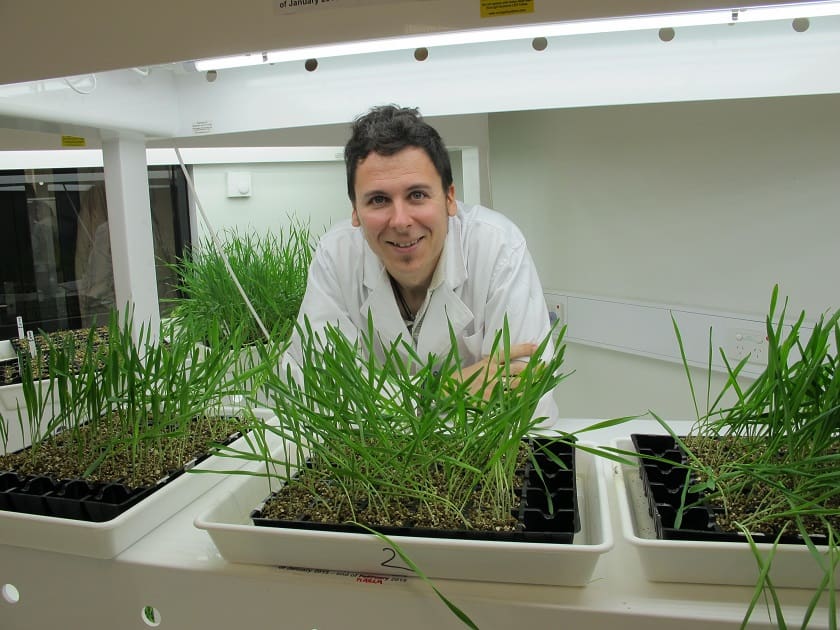WESTERN Australian researchers have discovered a new case of demethylation inhibitor (DMI) Group 3 fungicide resistance affecting barley crops in WA’s southern grainbelt region.

GRDC and Curtin University’s Centre for Crop and Disease Management Fungicide Resistance Group leader Fran Lopez-Ruiz is leading research into resistance in barley net type of net blotch. (Photo: CCDM)
Researchers from the Centre for Crop and Disease Management (CCDM), working closely with the Department of Primary Industries and Regional Development (DPIRD), found the resistance in the pathogen responsible for the disease net form of net blotch (NFNB), caused by the fungus Pyrenophora teres f. teres.
It was uncovered in samples collected by DPIRD plant pathologists in the Scaddan area, near Esperance, and sent for testing to the Grains Research and Development Corporation (GRDC) and Curtin University-supported CCDM.
CCDM researchers first discovered NFNB isolates with reduced sensitivity to Group 3 fungicides in 2013 and mapped the occurrence between 2013 and 2016. Importantly, the newly discovered case in Scaddan has a higher resistance to Group 3 DMI fungicides than the previous identified cases.
According to CCDM Fungicide Research Group team leader Fran Lopez-Ruiz, the extent of this new type of fungicide resistance in WA is yet to be established and may not be limited to Scaddan.
“The populations collected from Scaddan are showing a higher resistance to the DMI fungicides tebuconazole and propiconazole, moderate levels of resistance to prothioconazole and low resistance to epoxiconazole,” Dr Lopez-Ruiz said.
CCDM researcher Wesley Mair has been leading the disease testing in the laboratory and is currently investigating barley samples from other areas of the grainbelt to determine the distribution of this new resistance across WA.
“It is early days in our attempts to quantify the spread of this form of resistance, but the sampling process is well underway and, as analysis progresses, we will be able to report any further findings of resistance,” Mr Mair said.
“Ongoing sampling and testing is crucial to helping the CCDM team identify not only new cases of fungicide resistance, but also which fungicides are effective in managing this problem.
“We can then assist growers, agronomists and advisers to make informed decisions when it comes to crop and disease management.”
CCDM co-director Professor Mark Gibberd said this latest resistance discovery highlighted the importance of maintaining a high level of monitoring of disease pathogens in the landscape.
“The Australian agricultural production system is becoming increasing dependent on both fungicides and improved crop varieties for pathogen control,” Professor Gibberd said.
“At the CCDM, research funded by GRDC and Curtin University focusses on the use and sustainability of fungicides, as well as genetic improvement of crops.
“Both approaches need to occur in concert and the recent findings highlight the rate of change that is occurring within the landscape and the need to consider implications for the long-term.
“It is now apparent that disease control measures for one pathogen may be potentially influencing the development of fungicide resistance in other pathogens.”
Dr Lopez-Ruiz has advised WA growers to consider implementing integrated disease management strategies for the further protection of crops this season and in future seasons.
“We do know the over-use of fungicides is a key contributor to the problem of fungicide resistance, so users should adopt best practice methods of application,” he said.
“Avoiding over-spraying and repeated use of the same fungicide group will help to ensure the longevity and effectiveness of the products we have at our disposal in the fight against crop disease.”
The discovery of DMI-resistant NFNB populations in barley in WA follows the detection of two cases of DMI resistance in the pathogen responsible for another type of net blotch – spot form of net blotch (SFNB) – in WA’s Esperance and South Stirling regions in 2016 and 2017.
Strategies to control net blotch during the current growing season:
- Choose mixtures with different modes of action (if available)
- Never apply the same Group 3 fungicide twice in a row
- Apply fungicides from Groups 7 and 11 no more than once per season
- Incorporate the use of seed dressing, in-furrow and foliar products containing fungicide mixtures from different chemical groups (such as 3 (DMI), 7 (SDHI) and 11 (Qol)) – in combination with limited use of propiconazole and no tebuconazole use
- Avoid using tebuconazole as a stand-alone product in barley for any disease
- Use other DMI-based mixtures (such as propiconazole, prothioconazole or epoxiconazole) only once, followed by mixtures containing another actives (preferably from the SDHI or QoI groups)
- If resistance is present, or suspected, avoid or minimise use of that mode of action – this will only further select for resistance
- Do not exceed label rates.
It is also recommended growers consider implementing across-season tactics to reduce the risk of net blotch outbreaks and resistance selection.
These include rotating crops or managing stubble to reduce disease carry-over and selecting more disease-resistant barley varieties to reduce potential disease severity.
Source: GRDC
For more information about the work of the CCDM’s Fungicide Resistance Group, visit www.ccdm.com.au/frg
See accompanying story, ‘Spot and stop barley blotch this winter’

HAVE YOUR SAY